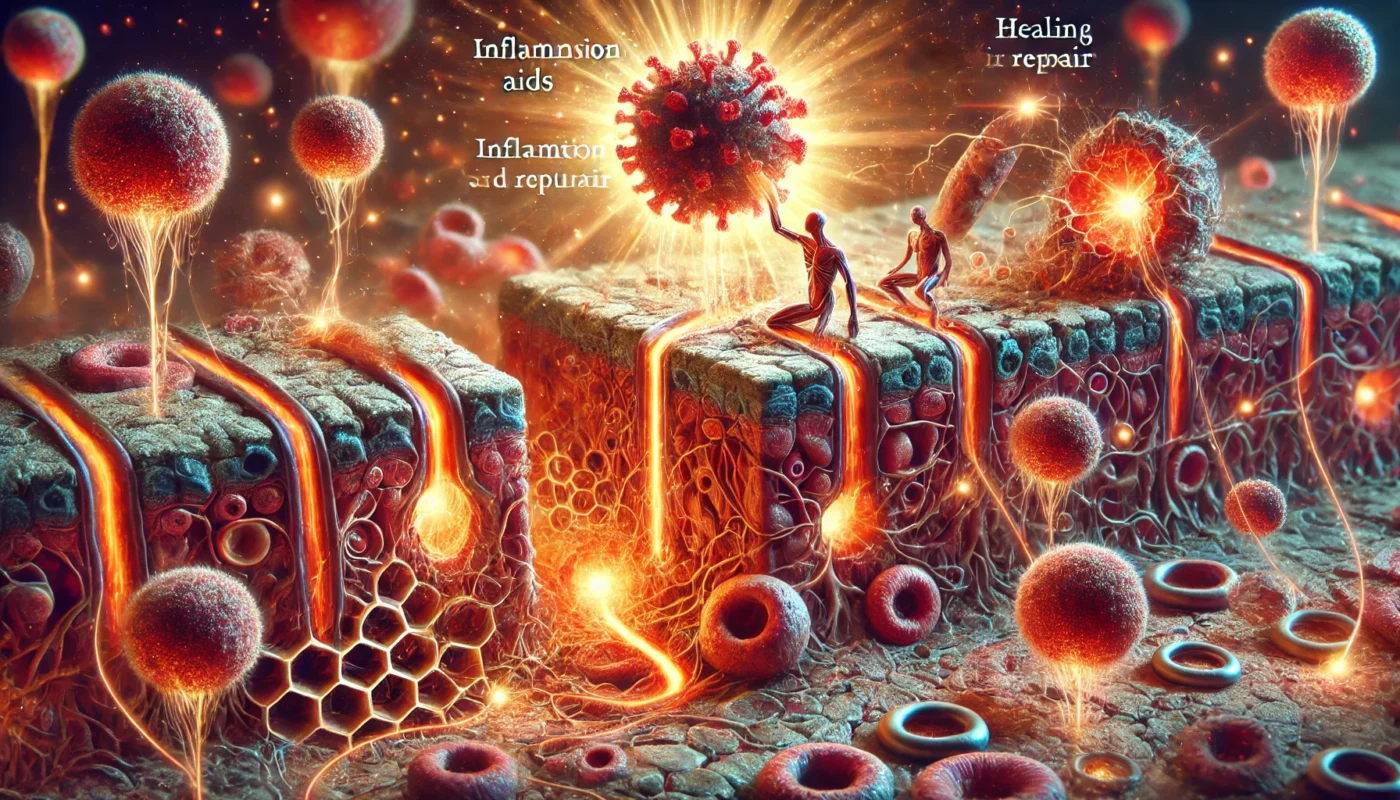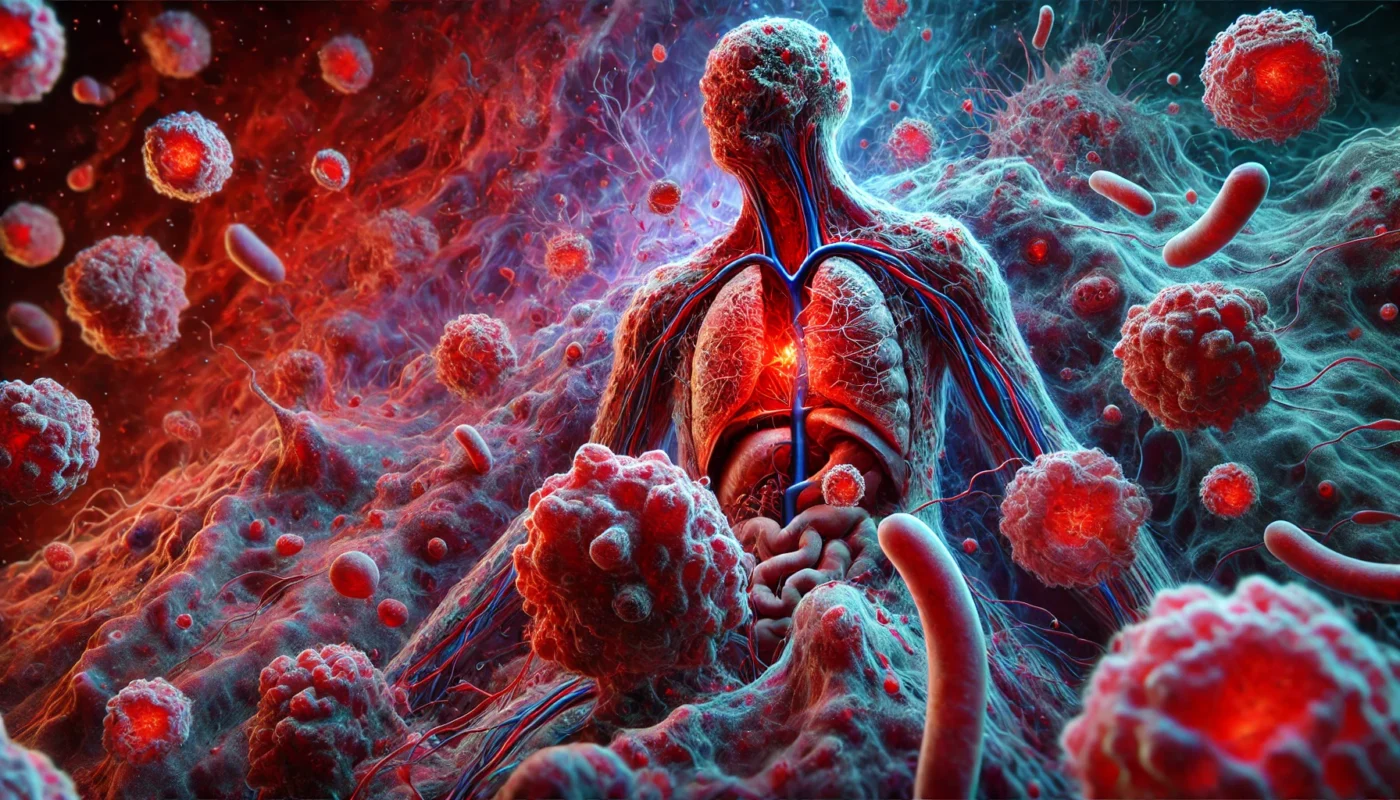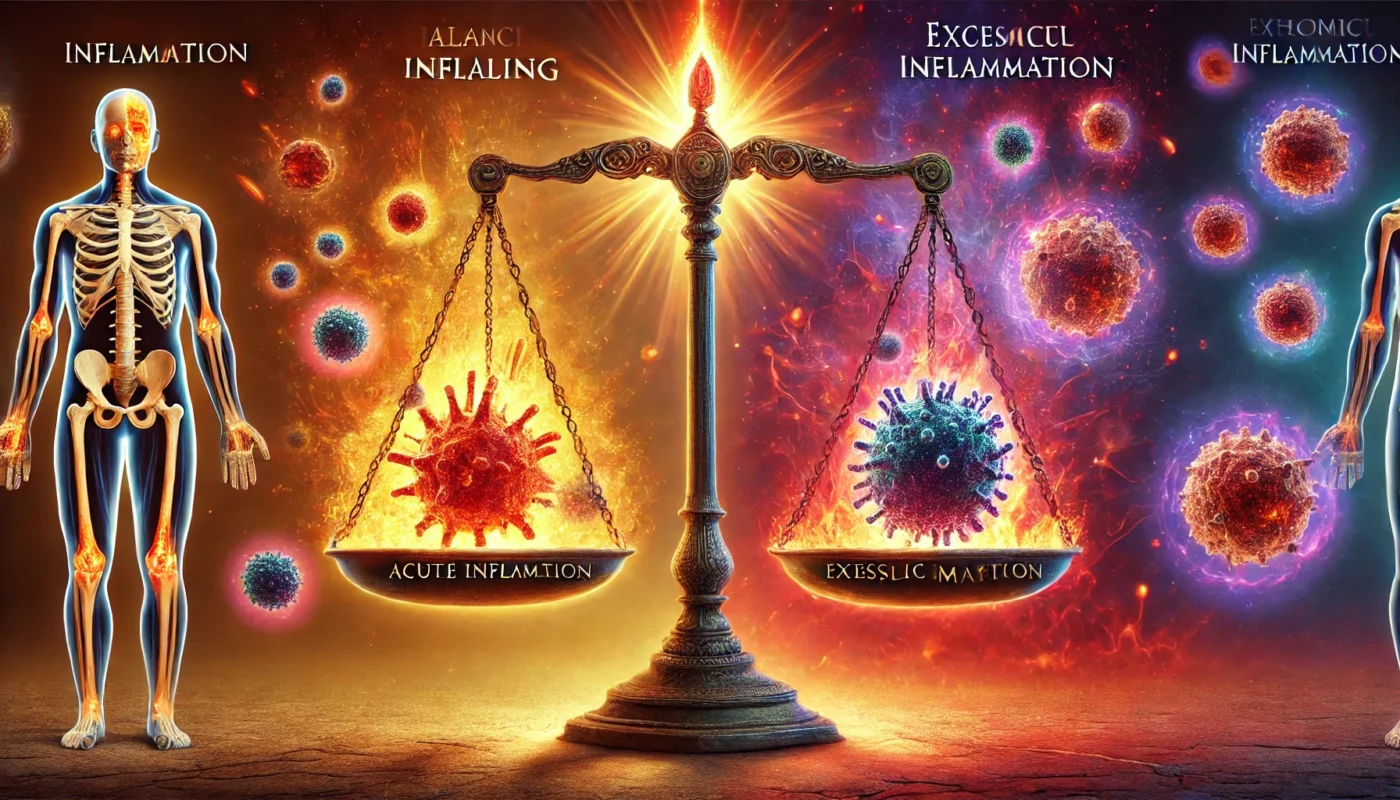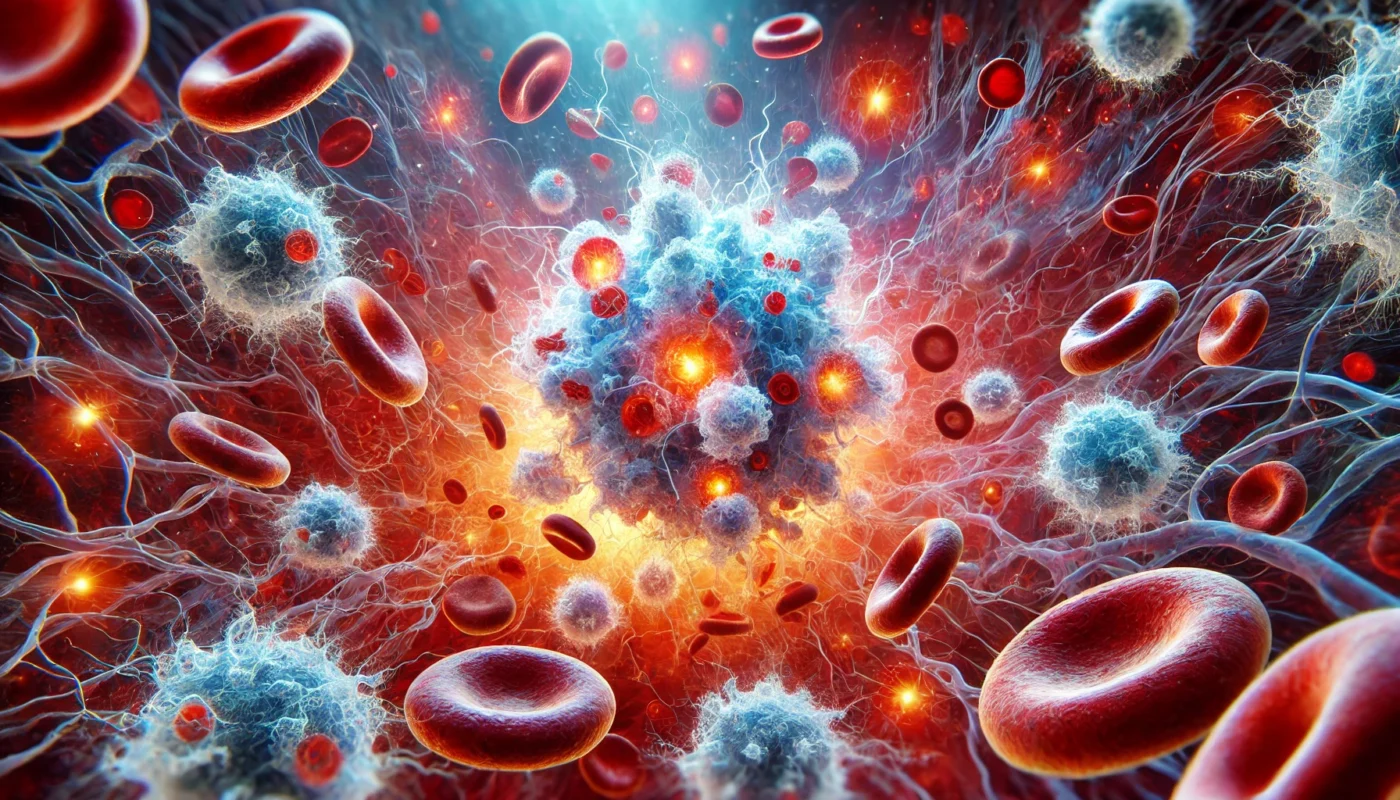Inflammation is the body’s natural response to injury or infection, designed to eliminate harmful stimuli and initiate the healing process. It’s a complex biological response involving various cells, proteins, and signaling pathways. Essentially, when your body senses an injury or pathogen, it releases chemicals that initiate an inflammatory reaction.
You may also like: 20 Powerful Anti-Inflammatory Foods
Defining Inflammation
At its core, inflammation is a protective response. The term “inflammatory” refers to the process that involves immune cells, blood vessels, and molecular mediators. When tissues are damaged, responding chemicals diffuse from damaged cells to the site of injury or infection, calling for immune cells to aid in defense and repair.
To understand inflammation, consider it as the body’s emergency response system. Much like firefighters rushing to extinguish a blaze, immune cells and proteins rush to the site of injury to contain damage and start the repair process. This involves an orchestrated series of events, starting from the identification of the problem to the resolution and repair of tissue.
There are two primary types of inflammation: acute and chronic. Acute inflammation is the body’s immediate and rapid response to injury, while chronic inflammation is a slower, long-term condition that may persist even after the initial threat is gone. Both types play different roles in health and disease.
Why is Inflammation Good?
Despite its bad reputation, inflammation plays a crucial role in immunity. It helps isolate the affected area, preventing the spread of infection. It also attracts immune cells, like white blood cells, to the site, aiding in the destruction of pathogens and the removal of dead cells. This is why inflammation is good and necessary for healing.
Inflammation serves as a critical alert system, notifying the body of potential dangers. It triggers healing by increasing blood flow and permeability of blood vessels, allowing essential nutrients and immune cells to reach damaged tissues. This rapid response is crucial in preventing the escalation of infections and promoting recovery.
Moreover, inflammation plays a vital role in activating adaptive immunity. This aspect of the immune response involves the creation of antibodies tailored to specific pathogens, providing long-term protection and memory against future infections. Without inflammation, the body would struggle to recognize and remember invaders, leaving it vulnerable to recurrent infections.
How Does Inflammation Help the Body?
The benefits of inflammation are vast and multifaceted. Let’s delve into how this biological process aids the body in maintaining health.
Fighting Off Infections
One of the primary benefits of the inflammatory response is its ability to help the body fight off infections. When pathogens invade, your immune system kicks in, causing inflammation to eliminate these threats. The swelling and redness you see are signs that your body is actively working to repair and protect itself.
Inflammation is the body’s first line of defense against pathogens. When a harmful microbe enters the body, the immune system detects it and activates the inflammatory response. This involves the release of chemical signals that increase blood flow to the affected area, facilitating the arrival of immune cells such as neutrophils and macrophages to engulf and destroy the invaders.
The inflammatory response also enhances the permeability of blood vessels, allowing larger molecules and cells to exit the bloodstream and reach the site of infection. This is critical for delivering antibodies and complement proteins that directly attack pathogens and aid in their removal.
Healing and Tissue Repair
Inflammation also plays a crucial role in healing and tissue repair. The increased blood flow to the affected area brings essential nutrients and oxygen, accelerating the healing process. Moreover, inflammatory cells secrete growth factors that promote tissue regeneration.
During tissue repair, inflammation facilitates the removal of dead cells and debris, clearing the way for new tissue formation. This cleanup process is essential for optimal healing and prevents the buildup of harmful materials that could impede recovery.
Inflammatory cells, such as macrophages, release growth factors that stimulate the proliferation of cells needed for tissue repair. These growth factors are essential for the formation of new blood vessels, a process known as angiogenesis, which ensures an adequate supply of oxygen and nutrients to the regenerating tissue.
As the healing process progresses, inflammation subsides, and the immune system begins to downregulate the inflammatory response. This transition is crucial for preventing excessive inflammation that could lead to tissue damage and scarring.

Inflammatory Reaction Process
The inflammatory reaction process is intricate. It begins with the recognition of harmful stimuli, followed by the recruitment of inflammatory cells to the site. These cells release mediators that propagate the response, leading to the classic signs of inflammation: redness, heat, swelling, and pain.
The initial phase of inflammation involves the recognition of pathogens or damaged cells by pattern recognition receptors (PRRs) on immune cells. This recognition triggers the release of pro-inflammatory cytokines and chemokines, which recruit additional immune cells to the site of injury.
Once recruited, these cells release a variety of mediators, including histamines, prostaglandins, and leukotrienes, which amplify the inflammatory response. These mediators increase blood vessel permeability, leading to the characteristic signs of inflammation.
As the immune system gains control over the threat, anti-inflammatory signals are released to resolve inflammation and promote tissue repair. This resolution phase is crucial for restoring normal tissue function and preventing chronic inflammation.
Is Inflammation Good or Bad?
Understanding whether inflammation is good or bad requires a nuanced perspective.
Acute vs. Chronic Inflammation
Acute inflammation is short-term and beneficial, as it represents your body’s immediate response to injury or infection. It’s a sign that your immune system is functioning properly. However, chronic inflammation is a different story. This long-term inflammation can cause harm, contributing to diseases like arthritis, heart disease, and even cancer.
Acute inflammation is a protective mechanism that resolves once the threat is eliminated. It is essential for healing and recovery, and its timely resolution ensures that tissues return to their normal state. Failure to resolve acute inflammation can lead to chronic inflammation.
Chronic inflammation occurs when the inflammatory response persists, either due to unresolved infection, continuous exposure to irritants, or autoimmune responses. This prolonged inflammation can lead to tissue damage and contribute to the development of various chronic diseases.
The transition from acute to chronic inflammation involves complex interactions between immune cells and signaling pathways. Understanding these processes is crucial for developing therapies to prevent and treat chronic inflammatory diseases.
Balancing Inflammation
To reap the benefits of inflammation without its drawbacks, it’s vital to maintain a balance. Lifestyle choices, such as a balanced diet rich in anti-inflammatory foods, regular exercise, stress management, and adequate sleep, can help regulate inflammation levels in the body.
Achieving a balance between pro-inflammatory and anti-inflammatory factors is key to maintaining health. A diet rich in antioxidants and polyphenols, found in fruits, vegetables, and spices, can help neutralize free radicals and reduce inflammation.
Regular physical activity promotes anti-inflammatory responses by enhancing blood circulation and reducing the production of inflammatory cytokines. Stress management practices, such as mindfulness and meditation, can also lower stress hormone levels, reducing inflammation.
Adequate sleep is essential for regulating the immune system and preventing the overproduction of inflammatory mediators. Prioritizing sleep hygiene and establishing a consistent sleep schedule can help maintain a healthy inflammatory balance.
Can Inflammation Kill You?
While inflammation is crucial for survival, unchecked chronic inflammation can contribute to life-threatening conditions. For example, chronic inflammatory diseases like rheumatoid arthritis or inflammatory bowel disease can significantly impact quality of life. Moreover, inflammation is a known contributor to atherosclerosis, which can lead to heart attacks and strokes.
Chronic inflammation is a silent contributor to many diseases. It can damage blood vessels, leading to the buildup of plaques that narrow arteries, a condition known as atherosclerosis. This increases the risk of heart attacks and strokes, the leading causes of death worldwide.
Inflammation is also implicated in the progression of cancer. Chronic inflammation creates an environment that supports tumor growth and metastasis by promoting angiogenesis and suppressing the immune response against cancer cells.
Autoimmune diseases, characterized by chronic inflammation, occur when the immune system mistakenly attacks the body’s own tissues. These conditions, such as lupus and multiple sclerosis, can lead to severe tissue damage and disability if not managed properly.

Practical Tips for Managing Inflammation
Given its dual nature, managing inflammation becomes paramount for overall health.
Dietary Approaches
A diet rich in fruits, vegetables, whole grains, and healthy fats can help reduce chronic inflammation. Foods like fatty fish, nuts, and olive oil contain omega-3 fatty acids, which are known for their anti-inflammatory properties. Conversely, reducing intake of processed foods, sugars, and trans fats can mitigate inflammation.
Incorporating a variety of colorful fruits and vegetables into your diet ensures a high intake of antioxidants that combat oxidative stress and inflammation. Foods such as berries, leafy greens, and cruciferous vegetables are particularly rich in anti-inflammatory compounds.
Omega-3 fatty acids, found in fatty fish like salmon and sardines, have been shown to reduce the production of pro-inflammatory cytokines. Including these foods in your diet can help balance inflammation and support heart health.
Limiting the consumption of processed foods and refined sugars is crucial for managing inflammation. These foods can increase the production of inflammatory mediators and contribute to obesity, a major risk factor for chronic inflammation.
Exercise and Lifestyle
Regular physical activity can help reduce inflammation. Exercise improves circulation, aids in weight management, and reduces stress—all factors that contribute to lower inflammation levels. Incorporating stress-reducing practices like meditation, yoga, or tai chi can also be beneficial.
Engaging in moderate-intensity exercise, such as brisk walking or cycling, for at least 150 minutes per week can significantly lower inflammatory markers. Exercise also stimulates the release of anti-inflammatory cytokines and enhances the body’s ability to regulate inflammation.
Stress management is essential for controlling inflammation. Practices like deep breathing, mindfulness meditation, and yoga can lower stress hormone levels and reduce inflammation. These practices also promote relaxation and improve overall well-being.
Maintaining a healthy weight through diet and exercise is crucial for managing inflammation. Excess adipose tissue produces inflammatory cytokines, contributing to systemic inflammation and increasing the risk of chronic diseases.
Supplements and Holistic Approaches
Certain supplements, such as turmeric, ginger, and green tea extract, have anti-inflammatory properties. However, it’s essential to consult with a healthcare provider before starting any supplement regimen. Additionally, holistic approaches like acupuncture or massage therapy can be effective in managing inflammation and pain.
Turmeric, containing the active compound curcumin, has been extensively studied for its anti-inflammatory effects. Curcumin inhibits the production of inflammatory mediators and can be a valuable addition to an anti-inflammatory regimen.
Ginger, a common culinary spice, also possesses anti-inflammatory properties. It can reduce inflammation and pain, particularly in conditions like osteoarthritis. Including ginger in your diet or taking ginger supplements may offer relief from inflammatory symptoms.
Holistic approaches, such as acupuncture and massage therapy, can help manage inflammation by promoting relaxation and improving circulation. These therapies can also alleviate pain associated with chronic inflammatory conditions, enhancing quality of life.

Conclusion
Inflammation is a double-edged sword—vital for defense and healing, yet potentially harmful if left unchecked. By understanding its role in immunity and employing strategies to maintain a healthy inflammatory balance, you can optimize your health and wellbeing. Embrace the power of inflammation to protect and heal your body, while taking steps to prevent it from becoming a chronic issue. Remember, a well-balanced approach to lifestyle and health can keep inflammation in check and enhance your overall quality of life.
Recognizing the signs and symptoms of inflammation can empower you to take proactive steps in managing it. Early intervention and lifestyle modifications can prevent the progression of inflammation-related diseases and improve long-term health outcomes.
Educating yourself about inflammation and its triggers enables you to make informed choices that support a balanced inflammatory response. Partnering with healthcare professionals for personalized advice and guidance is crucial for achieving and maintaining optimal health.
By integrating dietary, lifestyle, and holistic approaches, you can create a comprehensive strategy to manage inflammation effectively. This proactive approach not only enhances your physical health but also supports mental and emotional well-being, contributing to a fulfilling and healthy life.
Further Reading:
What Does Inflammation Do to the Body?
In brief: What is an inflammation?
chronic inflammation, atherosclerosis, heart health, cancer progression, autoimmune diseases, dietary approaches, anti-inflammatory diet, omega-3 fatty acids, exercise, stress management, supplements, holistic health, turmeric, ginger, green tea extract, lifestyle modifications, health optimization, inflammation management
Important Note: The information contained in this article is for general informational purposes only, and should not be construed as health or medical advice, nor is it intended to diagnose, prevent, treat, or cure any disease or health condition. Before embarking on any diet, fitness regimen, or program of nutritional supplementation, it is advisable to consult your healthcare professional in order to determine its safety and probable efficacy in terms of your individual state of health.
Regarding Nutritional Supplements Or Other Non-Prescription Health Products: If any nutritional supplements or other non-prescription health products are mentioned in the foregoing article, any claims or statements made about them have not been evaluated by the U.S. Food and Drug Administration, and such nutritional supplements or other health products are not intended to diagnose, treat, cure, or prevent any disease

